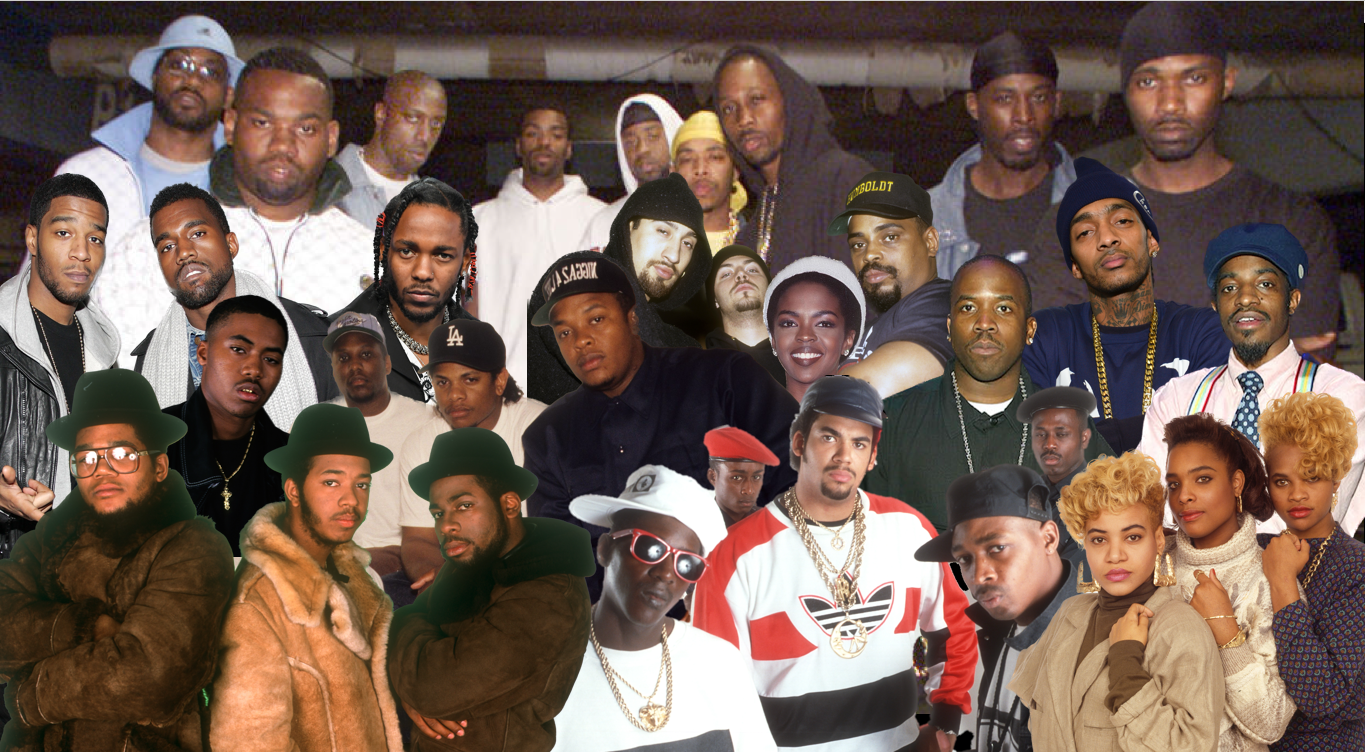 From its origins in the block parties of the Bronx to its current omnipresence in global pop culture, hip-hop has transcended being merely a musical genre — it’s an art form, a platform for social commentary, and a lifestyle. This cultural phenomenon has undergone a continuous evolution, propelled by groundbreaking artists who dared to push boundaries, address social issues, and defy the norm, shaping not only the rap scene but also the broader landscape of music and culture.
From its origins in the block parties of the Bronx to its current omnipresence in global pop culture, hip-hop has transcended being merely a musical genre — it’s an art form, a platform for social commentary, and a lifestyle. This cultural phenomenon has undergone a continuous evolution, propelled by groundbreaking artists who dared to push boundaries, address social issues, and defy the norm, shaping not only the rap scene but also the broader landscape of music and culture.
Examining the most impactful works in rap history allows us to grasp the transformative power embedded in this culture. Albums such as Kool G Rap & DJ Polo’s “Live and Let Die,” Ice-T’s “Rhyme Pays,” and Nas’ “Illmatic” have played a pivotal role in shaping the course of rap music. These works introduced innovative narrative styles, experimented with lyrical techniques, and added depth to the genre, serving as guiding lights and wellsprings of inspiration for countless artists who followed.
Yet, the influence of these highly significant rap albums extends beyond musical innovation. They courageously tackled crucial social issues, confronted stereotypes, and amplified the voices of marginalized communities. Whether it was Public Enemy’s impactful social commentary in “It Takes a Nation of Millions to Hold Us Back” or Ice Cube’s incisive critique of racial tensions in “AmeriKKKa’s Most Wanted,” these works resonated throughout society, compelling listeners to contemplate the world around them.
Hip-hop has perennially been a crucible of innovation, consistently pushing the boundaries of what’s musically achievable. From the sonic experimentation of Madvillain’s “Madvillainy” to the genre-blurring brilliance of OutKast’s “Southernplayalisticadillacmuzik,” these albums rewrote the rulebook, influencing artists across diverse genres and expanding the horizons of what is possible in music production.
So, let’s delve into it. From the groundbreaking sonic experiments of MF DOOM and Madlib’s “Madvillainy” to the genre-defying brilliance of Kid Cudi’s “Man on the Moon,” here are the top 50 most influential rap albums of all time.
#11 – Ghostface Killah – Supreme Clientele
(Lost to Nas’ Illmatic, 19% to 81%)
While the 1990s elicit great debate surrounding the greatest Wu-Tang Clan member solo works, Ghostface Killah threw a dart straight for the bull’s eye in Y2K. Supreme Clientele closely followed 1996’s Ironman with the swagger of a fighter already wearing the belt. “Ghost Deini” and “Apollo Kids” were ring-entrances, as a robed Ghost’ welcomed all challengers, lyrically and in the streets. As the sound of commercially-viable Rap had embraced fabric softener, messages like “Stay True” and “Buck 50” bloodied the gums of smile-at-the-camera posers. As the Rap playlist favored overt-samples, Pop-tinged choruses, and lots of R&B, Tony Starks’ penchant for the unconventional resonated brilliantly. Even playing by the rules of the game, a record like “Cherchez La Ghost” did so on rugged Shaolin terms—announcing that he’s too nasty for females, and no third verse at all. Like with Ironman, G.F.K. and his producers found a way to carefully inject 1980s Hip-Hop qualities. Although the mix and mastering of Supreme Clientele felt worthy of the Sony Records jacket, the would-be gold LP had the quality of a four-track recorder, and 12-second sampler. Dennis Coles stepped into the new millennium with grand visions of creativity, imagery, and coded slang, but he brought with him elements from his childhood that he refused to let go. More importantly, the LP’s lyrics are a step beyond the criminology heard on the debut. Largely inspired by a trip to Africa taken by Ghost’ and RZA, the album deals greatly with knowledge of self, heritage, and pride. Although G.F.K. was still menacing on the mic and in his details, the Gangsta Rap feel of the debut gave way to a more abstract texture. Supreme Clientele is the album that would catapult Ghostface Killah’s persona, and style through the next 20-plus years.
#10 – A Tribe Called Quest – The Low End Theory
(Lost to Wu-Tang Clan’s Enter The Wu-Tang (36 Chambers), 39% to 61%)
While 1990’s People’s Instinctive Travels & Paths Of Rhythm is a stellar album, A Tribe Called Quest hit their stride on 1991’s The Low End Theory. The Jazz-inspired LP would pocket a sound that A.T.C.Q. (now a trio, less Jarobi and with a significantly increased role for Phife) completely brewed up themselves—big on samples, wisdom, and an overall feel that melted just like “Butter.” The strong qualities of the group’s debut dispersed into beautiful arrangements, both vocal and musical—as heard immediately in single “Check The Rhime.” With one of the many featured Tip-and-Phife routines at center, the group casually waxed their history into a game-changing horn, bass, and drum concoction. That bass would be a defining feature of The Low End Theory—but not in the same way of the group’s Rap peers. With the acclaimed Ron Carter involved with the album, songs like “Buggin’ Out,” “Skypager,” and “Jazz (We’ve Got)” were as inspired by Charles Mingus as they were Afrika Bambaataa. However, in an era where many Hip-Hop acts were drawing on the glory days of Jazz, Quest was intent on never softening or stylizing their rhyme style. Album closer “Scenario” may be the group’s most aggressive mic display, with Phife aiming for the eyes, quite literally. For a group who would record together for less than a decade, The Low End Theory is a burden of proof as to why Tribe may be Hip-Hop’s greatest. This album is almost entirely self-contained, in terms of production, and lyrics. There are guests, but Phife, Ali Shaheed Muhammad, and The Abstract found their synergy on this effort. This album demonstrated how A.T.C.Q. could organically shape Hip-Hop, seemingly in their own vacuum. The Low End Theory is high-brow music, and a hallmark effort that so many artists dream of replicating in their own catalogs.
#9 – OutKast – Aquemini
(Lost to Eric B. & Rakim’s Paid In Full, 45% to 55%)
For a group that had helped make the South a destination for lyric-seekers in the 1990s, Big Boi and Andre 3000 appeared to be marginalized from the emerging mainstream movements of No Limit, So So Def, and Cash Money. However, with Aquemini, they sought little outside support—especially from those “face down in the mainstream.” Instead, the pair kept the circle tight and welcomed a bevy of session players into the Bobby Brown’s Bosstown Studios—which during the LP would become their privately-owned Stankonia. Upon exiting the lab, Outkast had another galactic gestalt of message-Funk stuffed with rhythms and flows that could not be replicated. “Rosa Parks” took the Civil Rights Movement’s inciting incident and illustrated how “the back of the bus” was actually where those in power wished to be. The fast-paced single broke from the a la carte offerings of the previous two albums but maintained the confident, socially-applicable premise and brilliant Rap commentary. Follow-up single (and next track on the album) “Skew It On The Bar-B” welcomed Wu-Tang Clan’s Raekwon for an effort that made a Dominique Wilkins-era dunk contest out of flow and cadence. At a time when Rap albums were seemingly seeking judgment based on video singles alone, Aquemini demanded to be looked at as a total sum of its parts. Deep cuts like “SpottieOttieDopaliscious” stretched a brassy groove with razor-sharp rhymes about reality and lifestyle shifts. On the album closer, “Chonky Fire,” guitars charged a sinister Stankonia seance—complete with an effortlessly human chorus to match the message. In Outkast’s final effort with Organized Noize and Mr. DJ taking on heavy production duties, Aquemini may be the group’s best marriage of rhymes and beats. Big Boi was a lyrical Barry Sanders, bolting up the field with his nimble flow and trademark cadence. Andre 3000 demonstrated a stick-and-moved with imagery, wisdom, and lines that prove to be Rap-relevant 20-plus years later.
#8 – Dr. Dre – The Chronic
(Lost to The Notorious B.I.G.’s Ready To Die, 46% to 54%)
When Dr. Dre left N.W.A. and Ruthless Records, the greatest material asset the Compton, California impresario may have had was musical sketches. Having hit his stride on N*ggaz4Life and The D.O.C.’s No One Can Do It Better, Andre Young built upon his G-Funk foundation, with an album that beckoned the galactic chariots of Parliament-Funkadelic themselves. While The Chronic paid homage to the ’70s, its rhymes were rooted in the grim reality of L.A. Riots-era South Central. Songs like “Lyrical Gangbang” weighed the messages and attitudes of young, disenfranchised Black men and women in the U.S., and wanted Middle America to feel the angst, the high stakes survival, and the fearlessness of the youth. Snoop Doggy Dogg would be Dre’s vehicle to pack one of Rap’s most laid-back flows (and attitudes) against the life or death realities of gang-infested Southern California. The Chronic was one of Rap’s first broad ensembles. Not a group, but a movement, the album called upon a crop of unknown and emerging talent from both coasts, all with skills to prove, and their best work ahead of them. Like Enter The Wu-Tang one year later, personnel knew that anything less than the best would not make the album. The hunger pangs of a cast that included Death Row Records’ would-be stars were manifested in an album that made its mastermind appear to be something of a Gangsta Rap Phil Spector. Dre created dynamic soundscapes built around samples, instrumentation, and a multitude of the slightest of tweaks. Within, he waxed a narrative that effectively spat at his former band mate Eazy-E, strong-armed Luke and 2 Live Crew, and overtook the industry with a forceful comeback statement. His LP was a cohesive, deeply-authentic party, and with its cinematic visual aides. The Chronic had everybody catching a contact—as this album’s wide tracks, extensive melody, and sharp-shooting role-players set the new standard in Hip-Hop. Although it’s surprisingly only triple-platinum, the diamond (status) is in the back of Dre’s symbolic ’64 Impala.
#7 – Raekwon – Only Built 4 Cuban Linx…
(Lost to Nas’ Illmatic, 28% to 72%)
Staten Island’s Chef and co-star Ghostface Killah showed the underbelly of the Shaolin crew in a linear effort about hustling, surviving shootouts, and backing down impostors on the block. “The Purple Tape” as it is affectionately remembered, is pure cinema. With John Woo’s Killer and Scarface excerpts throughout, Chef Rae brought narrative Rap albums to a boiling point. With the Clansmen in the wings—using their Wu-Gambino aliases, this LP drew a clear line for how the parts of the Clan body operated outside of their sums. For Rae’ and Ghost’ it was straight “Criminology.” The two MCs spit it in a way that could not be held up in a court of law, but violated so many Rap conventions. Raekwon’s writing style was impressionistic. The MC gave listeners the benefit of the doubt of putting the puzzles together—making it an active experience. “Glaciers Of Ice” melted the brain, with a fast-paced flow, and an inventive world. “Knowledge God” took (album guest) Nas’ “One Love” concept, and rewrote it in a way that the guards could not understand. Corey Woods waxed tales of heists, cocaine abusers, and the five boroughs that Times Square tourists never knew existed. For such an innovative lyrical style, RZA complemented accordingly. OB4CL’s sound is quirky, whimsical, and completely original. “Incarcerated Scarfaces” is as raw of a RZA drum arrangement as ever, with The Abbott laying down a Jazz-informed line, with light accents that made Rae’s essay 100% touchable. “Ice Cream” was a planetary lifted loop that captured the essence of late ’90s Hip-Hop a handful of years before others reached the frontier. “Rainy Dayz” had that same feel, as RZA’s reportedly shut-in Staten studio year led to weed-scented, eerie loops that scored the verbal grindhouse flick from Shallah and G.F.K. This marriage of tone and luster made The Purple Tape a complete experience.
#6 – Eric B. & Rakim – Paid In Full
(Lost to Wu-Tang Clan’s Enter The Wu-Tang (36 Chambers), 25% to 75%)
In mid-1987, Eric B. & Rakim changed the Hip-Hop landscape seismically through their Paid In Full debut. In an era when single syllabic rhymes in 4-4 time were still commonplace, Rakim stepped forth with a complex, but seemingly effortless flow. The Long Island, New York MC took on topics from his DJ, to his financial status, to his skyrocketing career, and made instant-certified dope. Calm and seemingly unaffected, Rakim was an entirely different MC than Run-D.M.C, Boogie Down Productions, or LL Cool J. However, he packed the same A-level of confidence. Meanwhile, DJ Eric B. (with reported help from Ra’ and Marley Marl) laced an album that took ’60s and ’70s records and seamlessly wove them against Rakim’s rhymes. “I Know You Got You Soul” pipe-lined the excitement of James Brown into the late ’80s, with a raw freshness. “I Ain’t No Joke” combined hard, panned drums with horn riffs—bridged together with scratching. Although the duo was using emerging technology, their organic rawness made the universe their studio. “Paid In Full” used drums as effectively as any song in its day, while Rakim took listeners on a journey, accented by effects under Eric. “My Melody” relied on synth-and-scratch in a way that bridged the gap between Hip-Hop, Pop, and New Wave. An eventual platinum album, this 10-track effort was a capsule of soulful Hip-Hop for 1987. Moreover, this LP all but closed the book on new MCs using simple rhymes and metronome flows. Rakim instantly threw his hat in the ring among the best. “Eric is president,” but Ra’ quickly stood tall as crowd commander-in-chief.
#5 – Public Enemy – It Takes A Nation Of Millions To Hold Us Back
(Lost to A Tribe Called Quest’s Midnight Marauders, 36% to 64%)
Public Enemy’s sophomore album is an intersection of substance and style at the highest possible level. A year-and-a-half removed from their stellar debut, Yo! Bum Rush The Show, Chuck D, Flavor Flav, Terminator X, and Professor Griff raised the stakes through an audio explosion. “Bring The Noise” ushered in the album’s barrage of hard-hitting lyrics. They outed inequalities, decried sample critics, stripped the glamour off drug use, and put a militia behind the movement. Chuck D found his greatest stride, not rapping as much as rhythmically proclaiming powerful verses into MC scripture. Flav played the consummate supporter, taking the role of hype-man to the top of class. Terminator X’s (and Johnny Juice’s) skills made the turntable more akin to the hard rock guitar, in its dazzling, head-banging display. Although It Takes A Nation… yielded monumental singles in “Rebel Without A Pause” and “Don’t Believe The Hype,” it contains few—if any—weak links. The album cut almost does not exist in the case of this Def Jam sophomore. Songs like “Louder Than A Bomb” and “Prophets Of Rage” resonate through the times, alongside the hits. P.E. made one of Rap’s premier end-to-end discs. With the issue-focused Chuck D, The Bomb Squad elevated their own craft. The stacked samples of Yo! Bum Rush The Show were intensified on the follow-up. Elements were sliced and chopped extra thin, with careful additions to the whole song. The lyrics of this album were heavy lifting for the mind, just as its sonic backbone was a workout for the ears. The raw energy of Heavy Metal was translated to Hip-Hop. Chuck’s Anthrax shout-out was not only telling, but a perfect explanation of the kind of energy and attitude that P.E. shared. While Public Enemy dismissed the Grammy snubs, they demonstrated the possibilities of the Hip-Hop album. Just minutes under an hour, It Takes A Nation Of Millions To Hold Us Back was social empowerment, and at times, propaganda.
#4 – The Notorious B.I.G. – Ready To Die
(Lost to Wu-Tang Clan’s Enter The Wu-Tang (36 Chambers), 33% to 67%)
When Ready To Die released in 1994, Biggie Smalls (officially known as The Notorious B.I.G.) was not a star. As he would rhyme on “One More Chance,” “Heartthrob, never / Black, and ugly as ever” is how the obese Brooklyn, New York MC described himself. However, the deeply anticipated Bad Boy Records debut had those in the know clamoring to hear a full work from the rapper who had dazzled in a handful of preemptive appearances. Christopher Wallace’s wordplay, impeccable timing, humor, booming voice, and self-deprecation stood out from the pack to the fullest. Upon releasing Ready To Die, he proved immediately that he had a story to tell. The Notorious B.I.G. never self aggrandized his album as a “concept,” it was simply his reality. Give or take a few facts bent a bit, and Biggie Smalls’ breakthrough effort reminded the world that Hip-Hop was for the people, by the people—so why not crown somebody who all seemingly related to? Ready To Die dealt with it all. The album presents Biggie from his days as a teased youth finding solace in Hip-Hop, to a deranged stick-up kid and corner hustler, eventually becoming a man who adored his mother and his daughter. “Juicy” fast became Hip-Hop’s rags-to-riches anthem, a meritocratic hope story for everybody with a dream. “Unbelievable” fused Biggie’s wit and syncopated delivery with DJ Premier’s pinnacle sound. The rhythms of each were completely in step, making hardcore Hip-Hop a true work of music mastery. “Ready To Die” and “Suicidal Thoughts” opened Biggie’s mind and vulnerability to a level that guarded MCs wouldn’t dare go. However, as Biggie transported the listener away to hustling trips down south, he could also open up the newfound glamor. Songs like “Big Poppa” could shape pop culture, and somehow hit their mark after the album released. This LP had both range and direction, and not only cemented Biggie’s royal Rap status as a rookie, it set the genre’s standard for the notion that a debut album should take your whole life to write. Ready To Die appeases Rap purists, story seekers, and those simply looking for a compelling listen. B.I.G. entered 1994 as a quick-witted freestyle specialist with a boisterously percussive delivery. He would leave the year as a Rap poet laureate, unafraid to put a coast, a street-rooted narrative, or an entire craft on his sturdy back. In many, many ways, Ready To Die showed Rap albums how to live in the years ahead.
#3 – A Tribe Called Quest – Midnight Marauders
(Lost to Nas’ Illmatic, 33% to 67%)
By 1993, Hip-Hop groups were hyper-aware of their legacy, as they challenged the laws of gravity. Coming out of the 1980s, few groups beyond Run-D.M.C. and De La Soul proved to be capable of three great albums in their catalog. And even those were not without arguments. A Tribe Called Quest, who broke in during 1990, weighed their winning streak entering Midnight Marauders, and won tenfold. The Jazz elements and breezy narratives of The Low End Theory continued, as Tribe remained ahead of the curve. Midnight Marauders demonstrated growth for Q-Tip, Phife Dawg, and Ali Shaheed Muhammad. However, in expanding, the Native Tongues found the spotlight—in their transformative first Top 10 album. Single “Electric Relaxation” beautifully merged Jazz and Electronic sources, for the perfect seduction. Cleverly sliced melodies drove the album, with groovy cuts like “Oh My God,” “Lyrics To Go,” and “We Can Get Down.” At a time when Jazz-Rap was a common theme on both coasts, A.T.C.Q. traveled to the next dimension and left no road map. The album featured smart, compelling lyrics that were far from preachy or taking themselves too seriously. Bars alluded to race relations, a changing New York City, and pressures of the Rap game, but songs seemingly didn’t. This LP was a casual, cohesive listen—which made it deeply accessible to the non-Rap consumer. The Abstract’s musings, Phife’s whimsicality, and Ali’s finest scratch clinic made A Tribe Called Quest one of the most consistent Hip-Hop acts of the first half of the 1990s. As the clock struck twelve, Midnight Marauders may be Tribe’s finest hour.
#2 – Wu-Tang Clan – Enter The Wu-Tang (36 Chambers)
(Lost to Nas’ Illmatic, 44.5 to 55.5%)
In late 1993, Wu-Tang Clan bum-rushed the show when they brought their own menacing cacophonous raucous. Enter The Wu-Tang is a tour de force of rugged raps, filthy beats, and a style that made Hip-Hop’s elite get out of the way, handing over the mic. RZA, GZA, Raekwon, Inspectah Deck, Ghostface Killah, U-God, Masta Killa, Method Man, and Ol’ Dirty Bastard were against the odds when they brought nine bodies to a Loud/RCA Records-backed album, and made all seem as organized as a rank-and-file military branch. With every MC offering something different, each vocalist distinguished himself with skill, vocal tone, and flow. Although they had their own internal dynamics, the Wu brought an unrivaled sense of family pride to outsiders. Songs like smash single “C.R.E.A.M.” and follow-up “Can It All Be Simple” proved that the common theme of hardships made this unit a pack of hungry wolves who resented aristocratic peers. Save for GZA and RZA, all the MCs were burgeoning to wax since 1992’s “Protect Ya Neck.” However, from O.D.B.’s “Shame On A N*gga” timing, to the “Method Man” routine all presented styles that felt like they were bottled in 1988, but fermenting, and getting all the more intoxicating while waiting for their chance. On one hand, Wu-Tang was futuristic in their dismissal of conventions. On the other, this was a head-trip back to the days of the late ’80s underground—battling in a smoke-filled subway car. In addition to delivering the most lucid, razor-sharp verses of his career, RZA made an album that sounded electric, alive, and dangerous. Break-beat arrangements on songs like “Wu-Tang Clan Ain’t Nuthing Ta F’ Wit” and “Wu-Tang: 7th Chamber – Part II” were accentuated with organs, special effects, and muted horns. Robert Diggs laced his jagged basslines with audio angel dust. With its rough texture, the album is incredibly cohesive, making skipping implausible if not impossible. Enter The Wu-Tang captivated Hip-Hop. It restored the comparative nature of over-stuffed Rap crews. It made every minute of an album feel precious internally and externally. The LP also made the Hip-Hop act feel like a militia, an outlaw posse, or a flash mob of witty, unpredictable voices with natural game. This LP not only served its nine creators with plush careers that followed, it made the industry take closer notice of what was really going on in the streets.
#1 – Nas – Illmatic
In only 10 tracks, Nas mounted a masterpiece in his early 1994 debut. The rugged-yet-introspective 20-year old from the Queensbridge Houses had been plugging away at his debut for nearly three years, constantly refining while studying the masters such as Rakim and Kool G Rap. A raspy-voiced, rhythmic MC, Nas also had esteemed sonic assistance from the likes of mentor Large Professor, DJ Premier, Q-Tip, and Pete Rock. With less than 40 minutes of album time, Illmatic was born into the universe as a great showing of early ’90s street New York imagery, an actualized Rap dream, and glimmering moments of the culture’s newest microphone prophet. Nasir Jones was clearly a vessel for the late ’80s-early ’90s’ promise, and an ensemble of greats gave this Columbia Records LP their all to ensure that he would be the next great one. Illmatic delivers on many levels, despite its relatively small confines. Songs like “Halftime,” “Represent,” and “NY State Of Mind” are rugged extensions of the Nas heard on Main Source’s Breaking Atoms, but as his own band-leader. These are the raw Rap tracks where an MC matched his impeccable timing with evocative wordplay about the cruel world as he saw it. “Life’s A B*tch” would prove how Nas could speak to the minds and attitudes of his people, with greater things to say on simple subjects than most. Quickly, the young man from the 41st Side stood as an ambassador for not just himself, but a culture and a generation. This was also true in the mainstream-tinged “It Ain’t Hard To Tell.” With a Michael Jackson sample, and Extra P’s surgeon-like arrangements, Nas found a hook to put his ill vernacular in a song that could cross over and grab new ears. Like Snoop Dogg across the country, Nas was at the forefront of his ability to bring an entire village to an album. Whether it was the slain Ill Will, the incarcerated Cormega, or kid brother Jungle, Nas made his project world into a diorama—between the compelling flows and mosaic beats. This was not just Hip-Hop, it was street reporting, and a return to undeniable authenticity when MTV music video era Rap was clearly favoring the sensationalized.
















